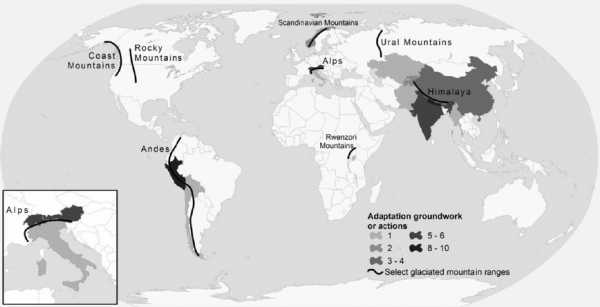Climate Change Adaptation is Key to Water Security

A significant research gap may be hindering community efforts to withstand climate-induced glacier melt, according to a new review from researcher Graham McDowell and his colleagues at McGill University.
Understanding how to help communities adapt to the effects of glacier melt, which threatens water sources for communities worldwide, will require deeper assessments of existing projects, the review found. A research agenda should focus on assessing different adaptation measures to better inform policy and community projects in the future.
Glaciers are key water sources in mountain areas, especially in South America and South Asia. More than 72 million people live in mountain regions, and large proportions of these populations reside in glaciated regions. Without glaciers, the livelihoods and health of communities worldwide will be threatened, but the issue is not well understood. Only 36 studies of adaptation projects have been published. In total, studies document 74 adaptations, mainly in Peru, India and Nepal, though the lack of research in this area suggests the number of existing adaptation plans may be greater than researchers have studied.
Almost 50 percent of documented adaptation plans are driven by a need to cope with the repercussions of climate change. Adaptation plans differ depending on how communities living near glaciers make their livelihoods, whether they are in ski towns in the European Alps or subsistence agrarian communities in the Himalayas and Andes.
McDowell found that most of the work on adaptation in glaciated regions comes from academic institutions, while NGOs and governments contribute much less. 50% of the projects in the papers which McDowell et al. reviewed concentrated in agricultural sector, followed by hazard management (31%), tourism (26%), water management (24%) and public health security (19%).
McDowell’s assessment suggests that adaptations to climatic changes are frequently embedded within responses to other socio-economic, political, and environmental challenges. To address these challenges, autonomous adaptation without government help at local scales may be especially important in often-remote glaciated mountain regions, where 58 % of adaptation initiatives were at an individual, household, or community scale, and 46 % were categorized as being autonomous, the review found.
Communities in need
South America, which holds more than 99% of the world’s tropical glaciers, is particularly vulnerable to global warming.
As climate change converges with human activities in glacier-filled mountains, the degradation of high Andean ecosystems is accelerating. These glaciers, which provide drinking water and sustain rivers, are crucial to water supply in South America and are used for agriculture, hydroelectricity and industry such as agro-exports and mining. At the same time, there are growing concerns that the rainy season will bring a higher risk of flooding, even if climate change leads to seasonal drought in the region. Facing abnormal rainfall, local farmers have to adapt to avoid economic loss.
Unavoidable glacier melt will severely reduce water supply in a continent that is already water-poor. In Peru, 8.9 million people live in rural areas and 3.3 million currently don’t have access to safe portable water. Around 3 million people, most of them children, die each year related to disease linked to consumption of contaminated water.
In order to provide more safe potable water, people are now trying to build large public facilities, such as reservoirs to store drinking water. However, microorganisms such as E. coli, Salmonella and Campylobacter are a concern as studies show increased temperatures favor conditions under which these microorganisms thrive.
A research agenda that addresses projects that can help communities adapt to the cascading effects of climate change is becoming increasingly urgent as the lives of millions come under threat.
For more information about adaptation in glacier areas, look here.

Facebook comments